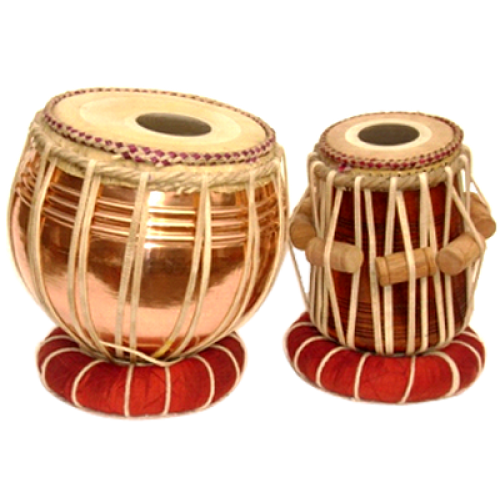Tabla is a pair of drums; it consists of a large left side drum called Bayan and a small right hand drum called Dayan. The left hand drum Bayan is made of iron, aluminum, copper, steel or clay, and has brass with nickel or chrome plate. The Dayan right hand drum is always made of wood. The most outstanding characteristic of the Tabla is the large black spot on each of the playing surfaces. These black spots are made of gum, soot and iron fittings. Their function is to create the bell-like timbre that is the main characteristic of this instrument. The origin of Tabla is assumed to be about 300 years ago from a barrel shaped drum called Pakhawaj.
The basic strokes on Tabla are:
- Ta: (on dayan) striking sharply with the index finger against the edge
- Ghe or ga: (on bayan) holding wrist down and arching the fingers over the syahi; the middle and ring-fingers then strike the maidan (resonant)
- Thin: (on dayan) placing the last two fingers of the right hand lightly against the syahi and striking on the border between the syahi and the maidan (resonant)
- Dha: combination of Na & Ghe
- Dhin: combination of Tin & Ghe
- Ka or kath: (on bayan) striking with the flat palm and fingers (non-resonant)
- Na: (on dayan) striking the edge of the syahi with the last two fingers of the right hand
- Tete: (on dayan) striking the centre of the syahi with the middle finger
- Ti: (on dayan) striking the centre of the syahi with the index finger (resonant)

Tabla Taals
Some Taals are very popular in Indian music like: Dhamaar, Ek, Jhoomra, and Chau taals are the slow and medium tempos. While some taals like: Jhap or Rupak flourish at faster speeds. Here is a list of some of the famous Taals in Indian music.
- Tintal or trital
- Jhoomra
- Tilwada
- Dhamar
- Ektal or chautal
- Jhaptal
- Keherwa
- Rupak
- Dadra
Gharana
The term Gharana is used to specify a ancestry of teaching and range in Indian Classical music. Most performers recognize two styles of Tabla Gharana: Dilli Baj and Purbi Baj. Dilli Baj came from the style in Delhi and Purbi Baj came from the style in eastern Dehli. Delhi Baj is also known as Chati Baj, which is supposed to be the part where a special tone on Tabla can be produced.